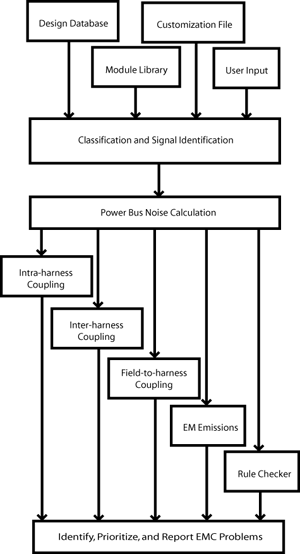
Overview of Automotive EMC Expert System AlgorithmsToday's automobiles rely heavily on electronics to monitor and control everything from the engine ignition, steering and braking to the entertainment, navigation and communication systems. Ensuring that the electronic systems operate reliably without producing or being susceptible to electromagnetic interference is a significant challenge. It is important to catch potential EMC design problems early in order to avoid having problems "pop up" in the later stages of development, when fixes are likely to be expensive and/or cause delays in the product release. Automotive EMC expert systems monitor the design of an automobile to identify potential EMC problems as soon as they arise [1, 2]. Like a human EMC expert, the software looks for potential sources and victims of electromagnetic interference and evaluates potential coupling paths between them. Unlike a human expert, expert system software is capable of investigating hundreds of possible system interactions and can repeat the entire process every time the design is updated. Structure of an Automotive EMC Expert System
The figure on the right shows a basic outline of tasks performed by an automotive expert system. Input is obtained from four possible sources. The primary source of information is the computer database that contains information about the mechanical and electrical design of the automobile. Information about the individual electronic modules that is relevant to an EMC analysis, but not available in the database is stored in a module library. The module library may contain default specifications for modules that are missing from the database as well as design specifications, signal definitions, test results and other data that is not part of the normal database structure. A customization file provides special instructions that pertain to a particular vehicle manufacturer or model. For example, instructions to treat a specific component differently than it would be by default based on previous experience with that component. Finally, information critical to the operation of the expert system that is not available from any other source must be provided by the user. User input should be optional and function only to provide the user with some degree of control over how the analysis is performed. Classification & Signal Identification Identifying and prioritizing potential EMC problems requires the system to be familiar with all wired and wireless electrical signals used to communicate between components in the vehicle. Unfortunately, this information is generally unavailable in vehicle design databases. Therefore, the first step in the analysis process is to examine the information that is available and attempt to describe all of these signals to the degree necessary to evaluate their impact on EMC. Classification and signal identification algorithms convert database information related to the components and component interfaces into signal amplitudes, frequencies and noise margins. They also identify the relative potential of the various signals to act as sources or victims of interference. A separate power bus noise calculation is performed in order to characterize the noise voltages and currents present on all power supply wiring. Coupling Algorithms The coupling algorithms quantify the worse-case coupling between all potential EMC sources and all potential victims. These algorithms can be divided into four categories; intra-harness coupling, inter-harness coupling, field coupling and EM emissions.
EMC expert systems are capable of analyzing complex systems relatively quickly and thoroughly. They perform tasks that would be relatively monotonous and time-consuming for a human Expert system EMC software does not replace the need for EMC testing nor is it a substitute for involving qualified EMC engineers in major design decisions. However, it excels at identifying potential problems early in the design process, when these problems can usually be avoided at little or no cost. As the importance and complexity of vehicular electronics increases, EMC expert system tools are sure to play an increasingly important role in the automotive design process. References[1] T. Hubing, "EMC expert systems for evaluating automotive designs," Proc. of the 2006 IEEE Int. Symp. on Electromagnetic Compatibility, Portland, OR, USA, Aug. 2006, THPM-6-6. [2] S. Ranganathan, D. Beetner, R. Wiese and T. Hubing, "An expert system architecture to detect system-level automotive EMC problems," Proceedings of the 2002 IEEE Int. Symp. on EMC, vol. 2, Aug. 2002, pp. 976-981. [3] X. Dong, H. Weng, D. Beetner, and T. Hubing, "Estimation of maximum system-level crosstalk at high frequencies for coupled transmission lines," to appear in the IEEE Transactions on EMC in 2008. |